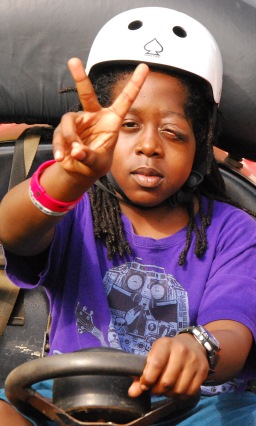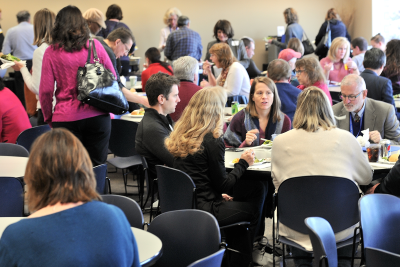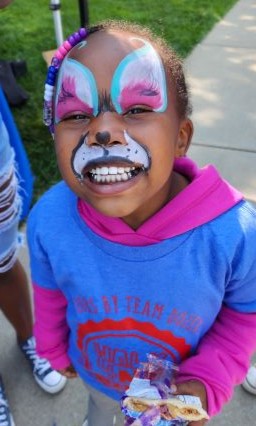iNFo Fair 2019: Cutaneous Neurofibromas
When I started as the executive director of NF Midwest in 2008 I had already served on the NF Midwest Board for 10 years. My husband has NF-1 and my two children, now 28 and 27, have NF-1. My experiences on the board, with the NF community, and with my family had given me a front row view of the needs of the neurofibromatosis community. The needs were, and continue to be, daunting.
While there are MANY concerns revolving around neurofibromatosis and schwannomatosis (really too many for one organization), I had several that I felt were neglected and I was determined to do whatever I could to move them into the light. One was cutaneous neurofibromas or the tumors that grow on and in the skin of most people with NF Type 1. It became clear to me fairly quickly that I was correct in my belief that this area was neglected. Even when parents of newly diagnosed babies would call, their first concern was almost always cutaneous neurofibromas…something that probably wouldn’t become an issue until at least the teenage years. I often had to tell them that while this was most concerning to them, it was far down on the list for clinicians and scientists.
I understood why cutaneous neurofibromas (let’s call them cNFs for the rest of this post) wasn’t high on the list of priorities…cNFs don’t cause death, or what clinicians would call a “high morbidity”. Meaning having them didn’t make people less healthy. Still I knew from our NF community, and because my husband has hundreds, probably thousands, of cNFs in varying sizes all over his body, that cNFs ARE A VERY BIG DEAL. They CAN affect people’s health by itching, hurting, bleeding, etc, but they especially impact people’s emotional, social, and financial health. Not feeling good about yourself; being lonely because others ostracize you; being stressed because you feel others are staring or you’re always trying to figure out how to cover up and what shirt might hide the worst of it; not having money for good insurance or good food because no one will hire you; ALL affect your physical health as well.
So what did I do? What did NF Midwest do? We talked about it and tried to influence any and every physician and researcher we could get in front of for years. Oh the stories we could tell about the questions and answers we received! If we went to a conference or had a symposium we’d pull them to the side, take them to dinner, pick them up at the airport, do whatever we had to get face to face.
We invited Dr. Weinberg, a well-known plastic surgeon to our symposium….TWICE. When we invited him the first time we were really the only organization at that time to embrace and welcome his technique. We knew there were still questions and concerns in the clinical community and we understood and had concerns of our own. However, we knew that people with NF-1 were going to him and believed that whatever he was doing was best, so we had to get it him in front of everyone, including the clinicians.
We also worked with a private citizen to get expanded codes from the American Medical Association (AMA) to cover the high quantity removal of cNFs through electro surgery vs. the very vague removal codes that existed.
Around five years ago I got myself in front of a particularly influential clinician researcher and gave my usual pitch which was something like….”It doesn’t matter what you or I think about cNFs, it matters what the people having them think and how they feel”; “Yes, if we removed a ton, they will may still have a ton, but if they feel better that’s what matters”; “If you don’t do anything about looking at removal or drugs, doctors outside of the NF clinical and research community are going to do it and we’ll have no data on it.”. They expressed their apprehension and concerns, but months after that, this clinician researcher contacted me because they decided to put together a conference on cNFs. A little bit after that they, along with others, decided to add a cNF working group to REiNS (Response Evaluation in Neurofibromatosis and Schwannomatosis Collaboration) because they were now going to look at treatments for cNFs. Last December, we learned that they are also going to look at the surgical techniques to evaluate quality of life and the effectiveness of “electrodessication” and CO2 Laser (used in Europe).
Now, to the point of why I am telling you all this. Over the years, and especially in the last year or so, I’ve learned a lot more about cNFs in general and also about possible treatments. I’ve also seen a lot of misinformation and misunderstandings and realize that we need to share what we know. This is why we’ve invited FOUR different people to present on cNFs at our November 9th symposium. We’ve worked very hard to come up with speakers to thoroughly cover and blanket this subject, still we know that these FOUR won’t cover it all.
This is a rare opportunity to really learn a lot about cutaneous neurofibromas as well as present and future treatments.
Below are summaries of the presenters and speakers for our special cNF session at NF Midwest’s NF Symposium and iNFo Fair.
- Matt Steensma, MD a surgeon-scientist from Spectrum Health and the Van Andel Institute in Michigan will teach us about the genetics and biology of cutaneous neurofibromas. Dr. Steensma, is an orthopedic oncology surgeon and neurofibromatosis researcher. In 2014, he was an inaugural winner of the Francis S. Collins Scholars Program in Neurofibromatosis Clinical and Translational Research.
- Ashley Cannon, PhD, MS, CGC, will review what is known about the natural history of cNFs and most excitedly, about new trials using MEK inhibitor drugs for the treatment of them. Dr. Cannon is a neuroscientist and certified genetic counselor at the University of Alabama at Birmingham. She is a 2016 recipient of the Francis S. Collins Scholars Program in Neurofibromatosis Clinical and Translational Research.
- Lu Le, MD, PhD is a professor of Dermatology and neurofibromatosis researcher at the University of Texas Southwestern Medical School where he is also a clinician in the NF clinic there. Dr. Le will talk about surgical options for removing cNFs, including a technique he’s developed that can be performed by any health care providers (including general practitioners) to remove multiple tumors at a regular medical office visit.
- Marsha Malloy, RD, BSN, MBA from the Medical College of Wisconsin will talk about photodynamic therapy for the reduction of cNFs.






.png)





